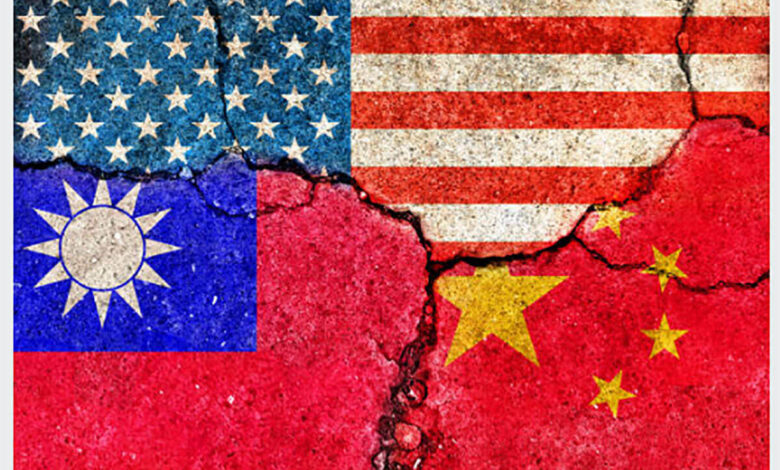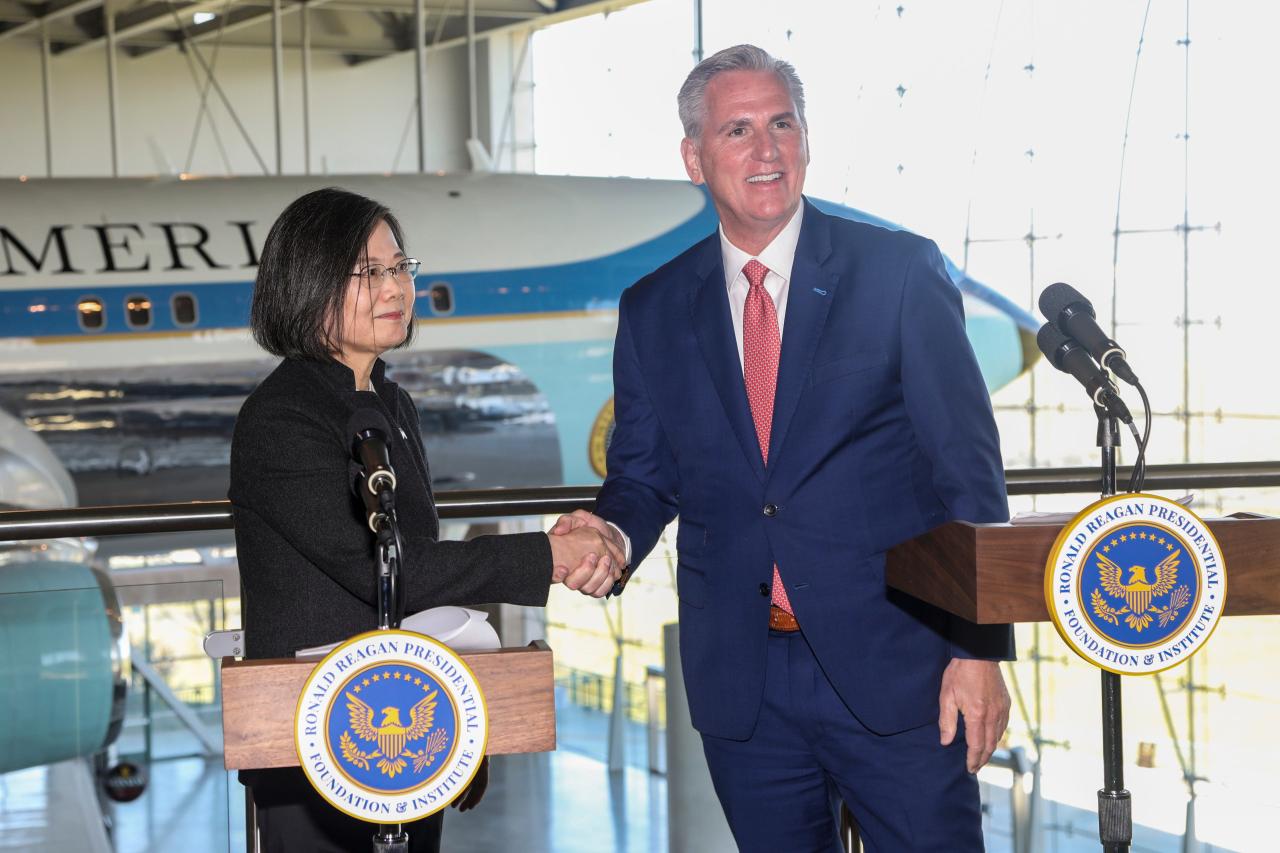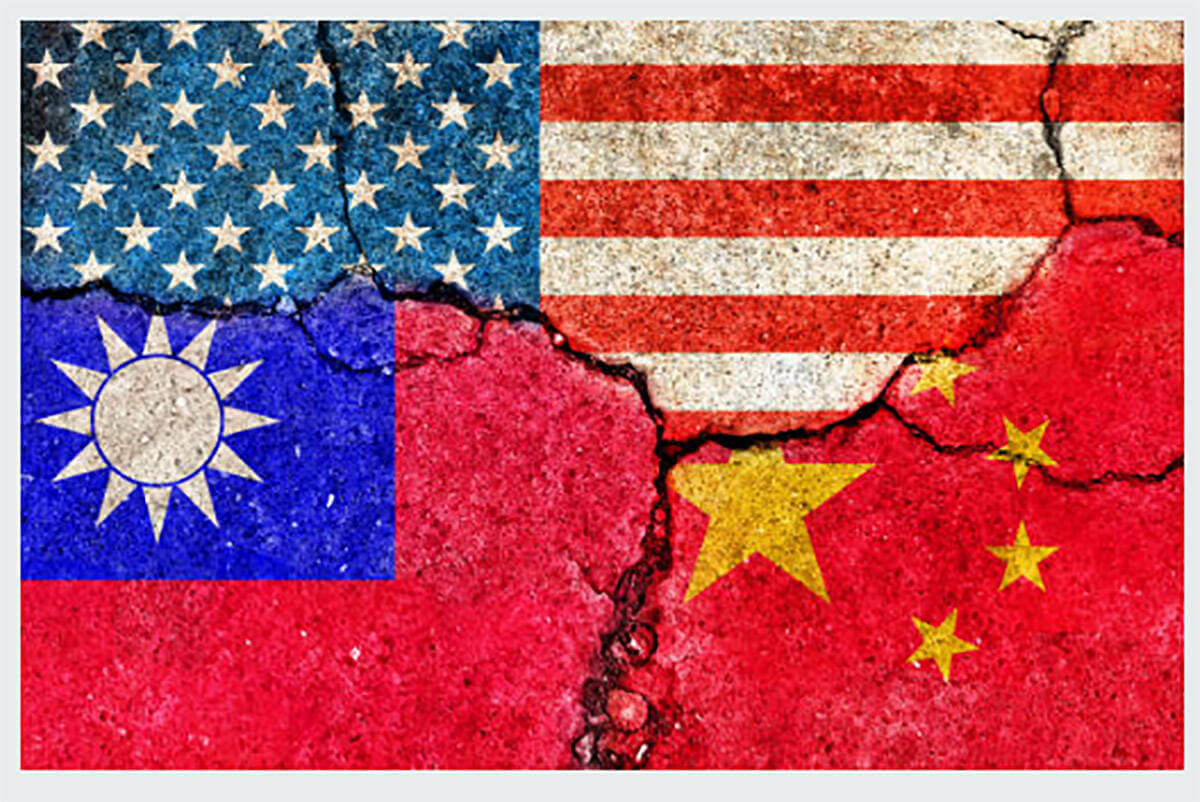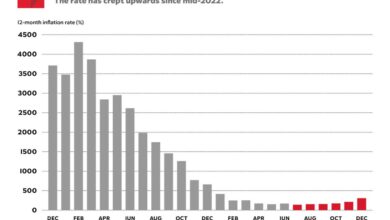
Taiwan United States Views A Complex Relationship
Taiwan United States views are a complex tapestry woven from history, current policy, and economic interdependence. This post delves into the intricate relationship, examining the historical context, current US policy, and the potential scenarios that could shape the future. From the Taiwan Relations Act to the region’s economic significance, we’ll explore the multifaceted perspectives and challenges surrounding this crucial relationship.
The relationship between Taiwan and the United States is a delicate balance of strategic interests, historical ties, and economic realities. Understanding this balance is crucial for comprehending the potential for conflict or cooperation in the future.
Historical Context

The relationship between Taiwan and the United States is a complex tapestry woven from strategic interests, historical contingencies, and shifting geopolitical landscapes. Understanding this relationship requires examining its evolution through key events and shifts in policy, as well as the evolving strategic interests of the United States in the Asia-Pacific region. This historical overview illuminates the intricate interplay between US government statements and actions concerning Taiwan.The US position on Taiwan has been influenced by its broader foreign policy objectives in Asia and its commitment to international norms.
Throughout this history, the US has navigated a delicate balance between maintaining its strategic interests in the region and avoiding direct confrontation with China, a factor that has significantly shaped its approach towards Taiwan.
Early Interactions and the Taiwan Relations Act
The United States initially recognized the Republic of China (ROC) as the legitimate government of all of China, including Taiwan. This recognition stemmed from the Cold War context, where the US sought to contain the spread of communism. However, this recognition was contingent on the evolving geopolitical dynamics. The US established diplomatic relations with the People’s Republic of China (PRC) in 1979, formally recognizing the PRC as the sole legitimate government of China.
This significant shift in policy did not, however, result in the abandonment of US interests in Taiwan.
The Taiwan Relations Act and its Significance
The Taiwan Relations Act of 1979 was a crucial turning point. It established the US policy toward Taiwan, committing the US to provide Taiwan with the means to defend itself against potential threats. The Act affirmed the US commitment to Taiwan’s security, although it avoided a formal security treaty. This act, despite not providing a military alliance, serves as a significant legal framework outlining the US position and obligations.
Evolution of US Strategic Interests
The US strategic interests in the Asia-Pacific region have evolved over time. Initially focused on containing the Soviet Union, these interests have broadened to encompass economic considerations and the maintenance of a stable regional order. The rise of China as a major global power has further influenced US strategic thinking, adding economic and technological competition to the security considerations.
This shift in focus underscores the importance of the Taiwan issue in the broader context of US regional strategy.
Timeline of Key Events
- 1949: The Chinese Civil War concludes, and the ROC government relocates to Taiwan. This event marked the beginning of a period of political and military tension in the region, influencing the early US policy towards China.
- 1979: The US formally recognizes the People’s Republic of China, severing diplomatic ties with the ROC. This monumental shift in policy had a significant impact on US-Taiwan relations, necessitating the implementation of the Taiwan Relations Act.
- 1996: Taiwan’s presidential election leads to a period of heightened tension. The US responded with a show of naval force, signaling its commitment to Taiwan’s security.
- 2020: The United States and Taiwan have increasingly engaged in unofficial, yet substantial, exchanges in areas like trade, defense, and technology. This indicates a deepening partnership, though with considerable diplomatic sensitivity.
Public Statements and Actions
The US government’s public statements concerning Taiwan have consistently reflected the policy Artikeld in the Taiwan Relations Act. The US has reiterated its commitment to supporting Taiwan’s self-defense capabilities and maintaining stability in the Taiwan Strait. The actions of the US government, including arms sales and strategic consultations, further demonstrate its commitment. These actions are closely watched by regional powers and have implications for the balance of power in the region.
Current US Policy Towards Taiwan
The US policy towards Taiwan is a complex and delicate balancing act, rooted in a history of shifting geopolitical realities. Understanding this policy requires acknowledging the significant implications it holds for both the region and the global landscape. The US stance, while not advocating for Taiwan’s independence, is firmly committed to Taiwan’s self-defense capabilities.The US officially recognizes the “One China” policy, a diplomatic stance that acknowledges China’s position on Taiwan.
However, this acknowledgment doesn’t translate into full acceptance of Beijing’s claim over Taiwan. This nuanced approach has implications for how the US engages with Taiwan and China, particularly regarding military aid and diplomatic relations.
Official US Stance on Taiwan’s Status
The US government’s official position is not to take a stance on Taiwan’s ultimate political status. This stance is rooted in the Taiwan Relations Act, which guides the US approach. This ambiguity is a deliberate strategy designed to maintain stability in the region, avoiding direct involvement that could escalate tensions.
Taiwan’s relationship with the US is complex, marked by economic ties and security concerns. Thinking about the resilience of the human spirit, I was deeply moved by the work of photographer Gillian Laub, capturing the stories of Holocaust survivors in her powerful portraits. holocaust survivor portraits gillian laub These images remind us of the importance of remembering history, and by extension, the delicate balance of power and shared values that underpin the Taiwan-US dynamic.
Key Elements of the Taiwan Relations Act
The Taiwan Relations Act (TRA) is a cornerstone of US policy towards Taiwan. It Artikels the US commitment to Taiwan’s security and well-being. The act establishes that the US will not abandon Taiwan if attacked by China, although it doesn’t explicitly define what constitutes an “attack”.
- The TRA commits the US to providing Taiwan with defensive capabilities, allowing for the sale of arms and defense equipment. This provision has significant implications for Taiwan’s ability to defend itself, potentially deterring aggression from China.
- The act also prohibits the US from recognizing Chinese sovereignty over Taiwan. This non-recognition is a crucial component of the US’s strategic approach to the region, preventing explicit support for China’s claim.
- The act further stipulates that any change in the status quo must be resolved peacefully through diplomatic channels. This is a critical aspect, highlighting the US preference for non-military solutions to the Taiwan issue.
Role of US Military Presence in the Region, Taiwan united states views
The US military presence in the region is substantial, with naval deployments and air patrols frequent. This presence is designed to project power and deter potential aggression, while also maintaining a degree of ambiguity about the extent of US involvement.
- US military exercises in the region demonstrate a commitment to the defense of Taiwan. These exercises often involve naval and air forces and serve to underscore the US’s ability to respond to potential threats.
- The strategic positioning of US military assets, such as aircraft carriers and bases, is a critical component of this deterrence strategy. This positioning demonstrates the US’s willingness and capability to respond to events in the region.
- The US has a significant intelligence gathering presence in the region. This is a key component of monitoring potential threats and assessing the situation in the Taiwan Strait.
Potential Triggers for Military Intervention
Determining the precise triggers for US military intervention in the Taiwan Strait is complex and contingent on many factors. There’s no clear, universally agreed-upon threshold.
- A direct attack on Taiwan by China would likely trigger a strong US response. This is implicit in the Taiwan Relations Act.
- A significant escalation of tensions, such as a blockade of Taiwan or a significant act of aggression against Taiwanese citizens, could prompt US intervention. The response to such escalations would be contingent on the specific nature of the incident.
- The actions of other countries in the region, particularly those that could destabilize the region or support China’s actions, could also influence the US’s response.
Public Opinion and Discourse
Public perception of the US-Taiwan relationship is complex and multifaceted, influenced by a range of factors, including historical ties, economic interests, and geopolitical considerations. The US public’s understanding of the relationship is often shaped by media coverage, political discourse, and personal experiences. Public opinion is not monolithic, and significant variations exist across different demographics and political affiliations.A crucial aspect of this relationship is the potential for conflict.
Public perception of the consequences of a conflict over Taiwan is marked by uncertainty and a desire to avoid escalation. Understanding the potential costs and implications of military action, including the human and economic toll, is paramount in shaping public opinion. The potential for unintended consequences, and the wider regional impact of a conflict, are also key considerations for the US public.
US Public Perception of the US-Taiwan Relationship
The US public generally views Taiwan as a crucial partner, recognizing its democratic values and economic importance. Support for Taiwan’s self-determination and defense against potential aggression is a prevalent sentiment. However, there is also a recognition of the complexities of the situation, particularly concerning the potential for conflict with China. The public acknowledges the sensitive geopolitical nature of the relationship.
Public Opinion Regarding Potential Consequences of Conflict
The potential consequences of a conflict over Taiwan are widely perceived as serious and undesirable. Public concern over the devastating impact of military action on human lives, the economic disruption, and the broader regional instability is significant. This concern is often coupled with a desire to find peaceful resolutions and diplomatic solutions. The potential for escalation and the risk of a wider conflict are significant factors in public apprehension.
Differing Viewpoints Within the US Political Spectrum
Differing perspectives on Taiwan’s status exist within the US political spectrum. These differences are often tied to broader ideological and strategic considerations, including the role of the US in global affairs and the nature of its relationship with China. The extent to which interventionist or non-interventionist approaches are preferred plays a significant role in these contrasting viewpoints.
Comparison of Political Group Perspectives on Taiwan
| Political Group | Perspective on Taiwan’s Status | Approach to Conflict Prevention |
|---|---|---|
| Democrats | Generally support Taiwan’s self-determination and defense, emphasizing the importance of a robust US commitment to the region. Often advocate for stronger diplomatic engagement with Taiwan. | Prefer a mix of diplomatic engagement and military deterrence to prevent conflict. Prioritize maintaining regional stability and peaceful resolutions. |
| Republicans | Tend to support a strong US military presence in the region and a firm stance against China’s expansionist ambitions. Some favor a more assertive approach towards Taiwan. | Advocate for a robust military posture and a clear signal to China of US resolve. Believe a strong defense posture deters conflict. |
| Independents | More diverse views, ranging from support for Taiwan’s defense to a preference for a more neutral approach. Seek a balance between maintaining US interests and avoiding escalation. | May favor a more nuanced approach that considers a wider range of options, including diplomacy, economic pressure, and military deterrence. Prioritize de-escalation and peaceful resolutions. |
Economic Interdependence
Taiwan’s economic relationship with the United States is deeply intertwined, marked by significant trade, investment, and supply chain linkages. This intricate web of economic ties has profound implications for both economies, shaping policy decisions and influencing global stability. Understanding these connections is crucial for assessing the potential ramifications of any shifts in US policy towards Taiwan.The economic relationship between Taiwan and the United States is characterized by substantial trade volumes, particularly in high-tech sectors.
This interdependence, however, isn’t without potential risks. Disruptions in this relationship, whether due to political tensions or unforeseen events, could have far-reaching consequences for both economies. Understanding these potential consequences is paramount for policymakers and businesses alike.
Taiwan’s Importance in Global Supply Chains
Taiwan is a vital player in global supply chains, especially for semiconductors and other advanced technologies. Its sophisticated manufacturing capabilities and highly skilled workforce contribute significantly to the production of crucial components used in consumer electronics, computers, and a wide range of industrial applications.Taiwan’s dominance in these sectors creates a complex web of dependencies. A disruption to Taiwan’s economy or its access to global markets could significantly impact numerous industries worldwide, including those in the United States.
The potential for disruptions in the global supply chain highlights the need for diversification and resilience strategies.
Taiwan’s Economic Contributions to the US
Taiwan’s economic contributions to the United States are substantial and multifaceted. Taiwanese companies are significant investors in the US, creating jobs and fostering innovation in American businesses.
- Investment and Job Creation: Taiwanese investments in the US support a range of industries, from manufacturing to technology. These investments contribute to job creation and economic growth in the United States.
- Trade and Exports: Taiwan is a major trading partner of the US, with a significant volume of exports to the US. These exports often include high-tech components, crucial for maintaining the functionality of US-based industries.
- Technological Innovation: Taiwan’s technological prowess facilitates innovation in the US, as Taiwanese companies contribute to the advancement of technology and innovation in the US economy.
Potential Economic Consequences of a Conflict or Policy Shift
A conflict or significant shift in US policy towards Taiwan could have considerable economic repercussions. Disruptions in trade, investment, and supply chains could lead to disruptions across numerous sectors in both Taiwan and the US.
- Increased Prices and Inflation: Disruptions in supply chains could lead to shortages of critical components and an increase in prices for consumer goods and industrial products.
- Economic Recession: A severe disruption in trade or investment could lead to a contraction in economic activity and potentially trigger a recession.
- Geopolitical Instability: A conflict involving Taiwan could lead to broader geopolitical instability, potentially affecting global markets and trade routes.
Economic Ties Between Taiwan and the US
Taiwan and the US have strong economic ties, characterized by significant trade and investment flows. These ties are especially prominent in high-tech industries.
- Trade Volume: The trade volume between Taiwan and the US is substantial, with goods and services exchanged regularly between the two economies.
- Investment Flows: Significant investment flows exist between Taiwan and the US, reflecting a strong economic partnership.
- Supply Chain Integration: Taiwan’s role in global supply chains is essential, with US companies heavily reliant on Taiwanese components and manufacturing expertise.
International Implications
The US-Taiwan relationship extends far beyond the shores of the Pacific. The delicate balance of power in the region, and indeed globally, is significantly influenced by this dynamic. The potential for conflict, even a localized one, has ramifications that ripple through international alliances, trade agreements, and global security frameworks. Understanding the perspectives of other nations is crucial to comprehending the full scope of this complex issue.The international community is keenly observing the developments in the Taiwan Strait.
Nations are carefully considering the implications of a potential conflict, assessing the impact on global trade, and evaluating the possible shifts in the regional and international power structures. The actions of the United States and China in response to these developments are closely scrutinized and will undoubtedly shape the course of international relations in the coming years.
Reactions of Other Nations
Numerous nations, including Japan, Australia, and various European countries, have voiced concerns regarding the escalating tensions in the Taiwan Strait. These concerns are often linked to the potential economic disruptions and security implications that a conflict could bring. The possibility of a broader conflict, encompassing not just the region but also drawing in other major players, is a significant consideration for many countries.
Potential for International Involvement
The degree of international involvement in a potential conflict over Taiwan is a significant factor in shaping the dynamics of the situation. Several nations have expressed support for Taiwan’s self-determination or defense, while others maintain neutrality, prioritizing their own strategic interests. The potential for international involvement varies significantly depending on the nature and scale of any conflict.
International Community’s Response to US Policies
The international community’s response to US policies regarding Taiwan is multifaceted and nuanced. Some nations align with the US approach, emphasizing the importance of maintaining regional stability and upholding democratic values. Others express reservations, emphasizing the need for a diplomatic solution and the potential for unintended consequences. The interplay of these diverse viewpoints and national interests creates a complex web of alliances and potential conflicts.
Economic Interdependence and Conflict
A conflict in the Taiwan Strait would have significant economic repercussions. Many countries are deeply intertwined with Taiwan’s economy, particularly in sectors like electronics and technology. Disruptions in supply chains, potentially resulting from a conflict, could have widespread economic consequences globally. The interconnectedness of global economies necessitates a cautious approach to managing tensions in the region. Examples of such interdependence can be seen in the global reliance on Taiwanese semiconductor production for numerous technological advancements.
Taiwan’s relationship with the US is always a hot topic, and the recent tensions are definitely noteworthy. Meanwhile, the results of the New Hampshire Democratic primary ( results new hampshire democratic primary ) are shaping the political landscape, and will likely influence how the US approaches its foreign policy, including the stance on Taiwan. This could significantly impact the already complex relationship between the two countries.
The impact of a conflict on global economies would likely be substantial and far-reaching.
Taiwan’s relationship with the US is complex, with ongoing discussions about security and trade. While the US government navigates these delicate waters, President Biden’s recent push for infrastructure improvements in Wisconsin, as highlighted in the article taking on trump biden promotes infrastructure decade in wisconsin , shows a focus on domestic priorities that could indirectly affect the US’s global posture, influencing its approach to issues like Taiwan.
These developments, however, don’t necessarily alter the fundamental strategic views of the US towards Taiwan.
Potential Scenarios
The future relationship between Taiwan and the United States hinges on a complex interplay of factors, including evolving geopolitical dynamics, economic interdependence, and the actions of both parties. Predicting the precise course of events is impossible, but examining potential scenarios allows for a clearer understanding of the potential challenges and opportunities ahead. This analysis will explore several possible futures, outlining potential responses and implications for the region and the world.
Potential Scenarios Regarding Taiwan-US Relations
A range of scenarios can be envisioned, each with distinct characteristics and outcomes. These scenarios consider various levels of escalation and de-escalation in tensions, as well as the range of responses that Taiwan and the US might employ. The outcomes of these scenarios are not predetermined and depend on numerous factors, including the actions of other global powers.
| Scenario | Potential US Response | Potential Taiwan Response | Regional and Global Implications | Potential Outcomes |
|---|---|---|---|---|
| Status Quo | Maintain current policy of strategic ambiguity, providing defensive capabilities, and increasing diplomatic engagement. | Continue with economic development, military modernization, and strengthening of domestic security. | Continued regional stability with a focus on economic growth, but potential for heightened tensions if China escalates actions. | Sustained regional stability, but with underlying tensions. |
| Escalation of Chinese Pressure | Increase military presence in the region, potentially deploying advanced weaponry and conducting joint military exercises with Taiwan. Provide more robust security assistance to Taiwan, possibly including advanced defensive systems. Initiate stronger diplomatic efforts with allies to counter Chinese actions. | Increase military readiness, strengthen defensive infrastructure, and potentially explore the possibility of defensive alliances with other nations. Increase internal preparedness for potential conflict. | Significant regional instability, potential for military conflict in the Taiwan Strait, and global repercussions from a possible conflict. Economic disruptions in the region. | Potential for military conflict, economic disruption, and significant geopolitical shifts in the region. |
| Taiwan’s Declaration of Independence | Initial response likely to be a complex mix of diplomatic actions, economic sanctions, and military deterrence. The exact nature of the response will depend on the specific actions of China and the international community. Potential for military intervention to protect Taiwanese citizens, although this would likely be a last resort. | Strengthen diplomatic efforts to gain international recognition, potentially seek alliances with other nations. Possibly implement civil defense strategies and economic diversification plans. | Immediate and significant regional instability, potential for a military confrontation between China and the US and their allies, global economic uncertainty, and potentially a domino effect in other regions. | High likelihood of conflict and major geopolitical shifts in the Asia-Pacific region, potentially triggering a broader global conflict. |
| Peaceful Resolution Through Dialogue | Facilitate and mediate dialogue between Taiwan and China, pushing for diplomatic solutions and peaceful coexistence. Offer economic and security incentives for a peaceful settlement. | Actively participate in diplomatic efforts, proposing solutions that respect Taiwan’s sovereignty and rights. | Regional stability and economic growth, potential for a new era of cooperation in the Asia-Pacific region. | Long-term peace and stability in the region, with potential for increased economic integration and cooperation. |
Implications for the Region and Globally
The potential scenarios Artikeld above highlight the significant implications for the region and globally. A conflict in the Taiwan Strait would have severe economic repercussions, disrupting global supply chains, impacting trade, and potentially leading to a global recession. The impact on international relations would be profound, potentially altering the global power balance. Geopolitical alliances would be tested, and the stability of the international order would be at stake.
The peaceful resolution, on the other hand, would promote regional stability and economic growth, fostering cooperation and a more prosperous future.
Taiwan’s relationship with the US is complex, marked by mutual interests and occasional disagreements. Navigating these complexities often involves nuanced discussions, and understanding the different perspectives on naming conventions like the ones detailed in apellido bebe madre padre provides a fascinating glimpse into the cultural tapestry of the region. Ultimately, the US-Taiwan dynamic remains a crucial factor in regional stability.
Military Considerations
The military dimension of the Taiwan Strait situation is undeniably crucial. Understanding the balance of power, potential strategies, and the preparedness of both sides is vital for assessing the potential escalation of tensions. This analysis will examine US military capabilities in the region, potential US strategies, Taiwanese military readiness, and the overall implications for the US-Taiwan relationship.The US military presence in the Indo-Pacific region, while significant, faces challenges in projecting power quickly and effectively across vast distances.
Logistical concerns, including deployment times and supply lines, are significant factors in any potential conflict scenario. This necessitates a deep understanding of the region’s geography and the potential for protracted conflicts.
Taiwan’s relationship with the US is definitely a hot topic right now, with lots of discussion about the future. While the world focuses on fashion events like the Couture Didier Ludot 50th anniversary Paris celebrations here , it’s important to remember the complexities of these political dynamics. Ultimately, the US-Taiwan relationship will continue to be a significant player on the global stage.
US Military Capabilities
The US maintains a substantial military presence in the Asia-Pacific region, including naval bases, air bases, and forward-deployed troops. This presence is intended to deter potential aggression and project power in the region. The US Navy’s aircraft carrier deployments, along with its substantial air and naval capabilities, are a key component of its strategic posture. The US Air Force’s presence, including strategic bombers and fighter jets, contributes to this overall deterrence.
Potential US Military Strategies
Various strategies are conceivable, depending on the nature and scale of any potential conflict. These strategies could range from a limited response focused on deterring China to a larger-scale intervention to defend Taiwan. Factors like the level of Chinese aggression, the Taiwanese response, and the international reaction will influence the specific approach. These strategies could involve a combination of naval blockade, air power projection, and ground support, if necessary.
Taiwanese Military Preparedness
Taiwan possesses a considerable military force, primarily focused on defending against a potential invasion from China. This force is comprised of ground forces, air defense systems, and a navy. Taiwan’s defense strategy prioritizes deterring an attack and maximizing the cost of invasion for China. However, Taiwan’s military capabilities are limited compared to China’s, and the effectiveness of its defense will depend on factors like the speed and intensity of an attack.
Military Implications for the US-Taiwan Relationship
The military dynamic strongly influences the relationship between the US and Taiwan. The US commitment to Taiwan’s defense, as articulated in various statements and actions, shapes Taiwanese security perceptions. The level of US military support and the potential for a larger-scale conflict are key factors in shaping the nature of this relationship. Taiwan’s defense capabilities and its willingness to engage in military cooperation with the US are essential considerations for the future.
Diplomatic Strategies: Taiwan United States Views

The delicate balance of cross-strait relations hinges significantly on the diplomatic strategies employed by both the United States and China. The US, navigating a complex landscape of security concerns, economic ties, and international norms, must carefully consider its approach to Taiwan’s future. The potential impact of these strategies extends far beyond the island itself, potentially affecting regional stability and global trade.
Potential US Diplomatic Strategies
The US has a range of diplomatic tools at its disposal to address the Taiwan issue. These strategies encompass both direct engagement with China and indirect actions aimed at fostering international support for Taiwan.
- Maintaining the current “strategic ambiguity” approach. This approach, while maintaining a degree of uncertainty about the US response to a potential Chinese attack, aims to deter China through a show of force and commitment without explicitly guaranteeing military intervention. However, this ambiguity can be interpreted differently by various parties, potentially increasing the risk of miscalculation.
- Strengthening Taiwan’s international presence. This involves bolstering Taiwan’s diplomatic ties with other nations, expanding its participation in international organizations, and promoting its economic and political standing on the world stage. This strategy is designed to increase Taiwan’s legitimacy and deter potential Chinese aggression.
- Enhancing international pressure on China. This could include imposing sanctions on Chinese entities or individuals involved in activities that threaten Taiwan or international stability. Such pressure can increase the cost for China of taking aggressive actions. This can be done in conjunction with allies to amplify the impact.
- Engaging in multilateral dialogues. These dialogues involve bringing together key stakeholders to discuss and address concerns regarding Taiwan. This could include international organizations or regional forums, allowing for a broader range of perspectives to be considered and potentially fostering cooperation.
Impact of Diplomatic Strategies
The effectiveness of any diplomatic strategy depends on various factors, including the specific context, China’s response, and the actions of other nations.
- Deterrence. Strategies that emphasize a strong US commitment to Taiwan’s defense and potential consequences for China can deter further escalation. However, the credibility of such commitments is vital. Successful examples include the responses to Russian aggression in Ukraine.
- De-escalation. Diplomatic efforts to establish communication channels and de-escalate tensions are crucial to preventing conflict. These efforts may involve direct dialogue, confidence-building measures, and finding common ground.
- International Support. Building international support for Taiwan can increase pressure on China and bolster Taiwan’s position. This can be done through alliances, agreements, and declarations.
Diplomatic Avenues for De-escalation
Finding common ground and de-escalating tensions requires a nuanced approach.
- Direct Dialogue. Maintaining open communication channels between the US and China, even if disagreements persist, is essential for managing potential crises. Historical examples of this are numerous and vary in effectiveness, highlighting the need for continuous and adaptable approaches.
- Confidence-building Measures. Implementing measures that reduce the risk of miscalculation and enhance mutual trust, such as joint military exercises or arms control agreements, can significantly lower the risk of conflict. These measures need to be specific, verifiable, and mutual.
- International Mediation. Bringing in neutral third parties to facilitate dialogue and negotiation can provide a platform for resolving disputes. The role of international organizations, such as the UN, can be crucial in mediating disputes.
Historical Diplomatic Efforts
Past diplomatic efforts to resolve the Taiwan issue have had varying degrees of success.
- The 1979 US-China relationship. The normalization of relations between the US and China has profoundly impacted the Taiwan issue. It shifted the US’s approach, leading to the current strategic ambiguity policy.
- UN Resolutions and Declarations. UN resolutions and declarations on the issue have addressed certain aspects of the issue, yet haven’t resolved the underlying political and territorial disagreements. Their effectiveness in practice varies widely, and it’s important to consider the historical context in each instance.
Illustrative Examples
The Taiwan Strait, a strategically vital waterway, is a flashpoint for potential conflict. Understanding potential scenarios and their escalation pathways is crucial for assessing the risks and developing appropriate responses. Hypothetical incidents, while not predictive, can illuminate the complex interplay of factors that could lead to a crisis. This section explores a specific incident and its potential ramifications.
A Hypothetical Incident in the Taiwan Strait
A Chinese air force aircraft, on a routine patrol, encounters a Taiwanese air force jet in a contested air space. The encounter escalates quickly due to miscalculation or miscommunication, resulting in a near-collision. The incident is widely publicized by both sides, with each claiming the other was at fault.
Potential Escalation Pathways
The initial near-collision could trigger a series of events that escalate rapidly.
- Escalation through miscalculation: Both sides may react based on perceived threats rather than a fully considered response, leading to further incursions into the contested airspace. Military commanders on both sides may act with a perceived urgency to prevent the loss of face, leading to further actions, including increased deployments of military assets in the region. Previous incidents in the South China Sea, where misjudgments escalated tensions, provide a cautionary tale.
- Escalation through external actors: Other countries might become involved through their alliances or through concerns about regional stability. This could result in diplomatic pressure or, in a worst-case scenario, direct military intervention. The South China Sea dispute, where external powers have been involved, highlights this risk.
- Escalation through cyber warfare: Following the air incident, each side might respond by targeting critical infrastructure of the other, potentially leading to a full-blown cyber conflict. Examples of cyberattacks, such as those targeting Ukrainian infrastructure during the 2022 Russian invasion, serve as a stark reminder of the potential impact.
Impact on the US-Taiwan Relationship
The incident’s impact on the US-Taiwan relationship would be profound. A significant escalation could strain the already close security and economic ties between the two.
- Increased US military presence: The United States might increase its military presence in the region, which could be interpreted by China as a provocative act. The potential for a military response from China further escalates the tension.
- Increased Taiwanese defense spending: Taiwan might significantly increase its defense spending and strengthen its military capabilities to deter further Chinese aggression. This could lead to an arms race, creating further instability.
- Potential for US intervention: The US commitment to Taiwan’s defense, under the Taiwan Relations Act, might be tested. The US might respond by sending more military assets or taking other actions, which could have unforeseen consequences.
Detailed Illustration of a Specific Event
Imagine a Chinese air force fighter jet intercepts a Taiwanese reconnaissance drone operating in a contested airspace zone. The Chinese pilot, misjudging the drone’s intentions, takes evasive action, which results in a near-collision. Both sides report the incident to their respective governments.
Responses and Outcomes
The initial response would likely be a series of escalating pronouncements from both governments.
- International condemnation: Other nations would likely condemn the incident and call for de-escalation. The United Nations Security Council might issue a statement, although its effectiveness would depend on the level of international consensus.
- US diplomatic efforts: The United States would likely engage in intense diplomatic efforts to de-escalate the situation, potentially involving discussions with China. Past instances of US diplomatic interventions in similar situations offer a possible model for de-escalation.
- Economic consequences: The stock markets globally could experience volatility, and trade relations between China and Taiwan, and other countries involved, might be disrupted. Examples of past economic crises highlight the interconnectedness of global markets.
Conclusion
In conclusion, Taiwan United States views are deeply rooted in history and shaped by contemporary realities. The relationship is a complex interplay of political, economic, and military considerations. The potential scenarios for the future, while uncertain, underscore the importance of understanding this multifaceted dynamic. The future of the relationship remains uncertain, but a deep understanding of the past and present provides valuable insight into the potential paths forward.
Answers to Common Questions
What is the current US official stance on Taiwan’s status?
The US officially recognizes the People’s Republic of China as the sole legitimate government of China, but maintains a policy of “strategic ambiguity” regarding Taiwan’s status. This policy avoids a definitive commitment to defend Taiwan militarily, but nonetheless emphasizes the importance of peace and stability in the region.
What are some potential triggers for military intervention by the US in the Taiwan Strait?
Potential triggers include a Chinese attack on Taiwan, a significant escalation of tensions in the region, or actions perceived as jeopardizing regional stability.
How does public opinion in the US view the potential consequences of a conflict over Taiwan?
Public opinion on this is divided, with some favoring a strong defense of Taiwan and others emphasizing the potential costs and risks of military intervention.
What are the economic ties between Taiwan and the US, and what are the potential consequences of a conflict?
Taiwan is a critical player in global supply chains, and a conflict would have significant economic repercussions, potentially impacting US industries reliant on Taiwanese components and products.






